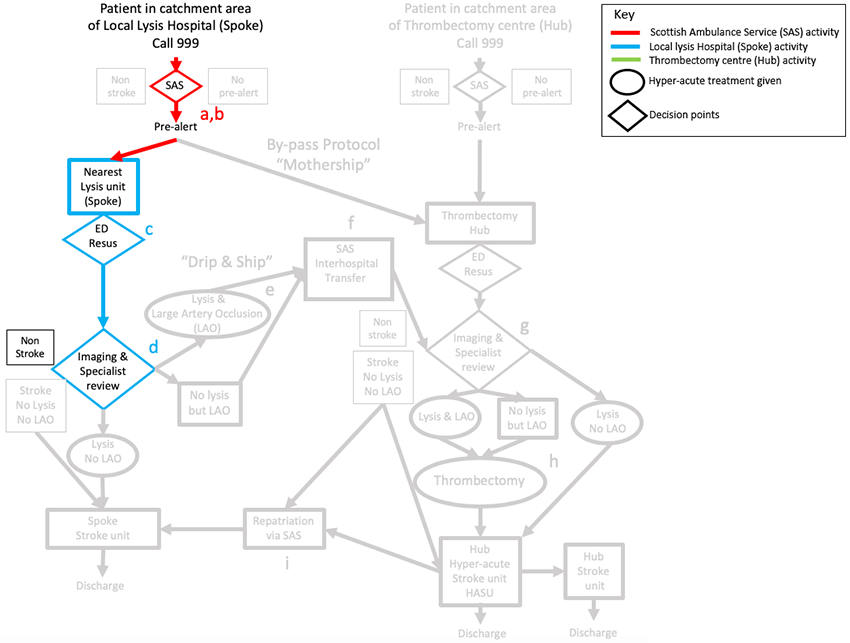Category: Advancing Modules
What is a pulmonary embolus (PE)?
What are pulmonary emboli?
- These are clots which have formed in the deep veins, have broken off and been carried through the right side of the heart to the lungs.
- PE may cause the patients to:
– complain of central chest pain or pleuritic pain associated with deep breaths
– become breathless, coughing, to be agitated and distressed - On examination they may be cyanosed with low oxygen saturation, have an increased respiratory rate, raised heart rate (tachycardic), low blood pressure (hypotensive)
- An ECG and chest X-Ray may be abnormal but the diagnosis is best confirmed with a CT pulmonary angiogram or Ventilation/Perfusion isotope (V/Q) scan
- Like DVT, patients may have pulmonary emboli without symptoms and many others with less dramatic symptoms may be misdiagnosed as having a chest infection, pneumonia or heart failure
- Pulmonary emboli may cause the patient to collapse and die suddenly
- A pulmonary embolus should be suspected in any stroke patient who becomes breathless or hypoxic
What is a deep vein thrombosis (DVT)?
- A deep vein thrombosis occurs when slow flowing blood clots in the veins deep in the calf or thigh
- It may be associated with pain, swelling, redness, distension of superficial veins and tenderness of the calf and/or thigh
- It may however be present but produce no symptoms at all
- Pieces of the clots in the veins may break off and be carried in the blood stream to the heart and lungs – these clots are called pulmonary emboli
- A DVT should be suspected in any patient on the stroke unit who develops a swollen leg
- It is important to look at patient’s calves regularly to see if they are red, hot or swollen and ask the patient if they are experiencing any pain. If you suspect swelling, measure the calf circumference and report it to the doctors.
Learning points
By completing this module you will learn a critical understanding of:
- The frequency of venous thromboembolism (VTE) in stroke patients
- The factors which increase patients risks of VTE after stroke
- Interventions which may be helpful in reducing the risks of VTE
- A detailed knowledge of how to use Intermittent Pneumatic compression
This module is divided into the following sections.
01. Introduction to venous thromboembolism (VTE) after stroke
- What is a deep vein thrombosis (DVT)?
- What is a pulmonary embolus (PE)?
- Factors causing clots (thrombosis) – Virchow’s triad
- What is the risk in stroke patients?
- Which stroke patients are at greatest risk?
02. Interventions which aim to reduce the risk
- Testing your knowledge about interventions to reduce the risk of DVT after stroke
- Aspirin
- Heparin or low molecular weight heparin
- Balancing the risks and benefits of anticoagulants
- Graduated compression stockings (GCS)
- Intermittent pneumatic compression (IPC)
03. Intermittent pneumatic compression (IPC)
- What does IPC comprise?
- Types of IPC
- Kendall SCD Express system
- Which patients should be treated with IPC?
- How long should we apply IPC?
- Selecting the correct size of IPC Sleeves
- Applying and monitoring the IPC sleeves
- Common mistakes in applying sleeves
- Optimising adherence to IPC
- Applying IPC – test your knowledge
- Troubleshooting IPC:
– Switching on the Kendall SCD Express
– The Kendall SCD Express control panel
– Types of alarms on SCD Express controller
– Cleaning the IPC equipment
– Troubleshooting IPC – Test your knowledge
Introduction

Module authors
Module lead
Prof Martin Dennis, Professor of Stroke Medicine, University of Edinburgh
Critical readers
Carol Williams, Division of Clinical Neurosciences, University of Edinburgh
Katrina Brennan, Stroke MCN Manager, NHS Lanarkshire
Trish Elder Gracie, Charge Nurse, NHS Lothian
Further resources

Frequently asked Questions (FAQ) regarding use of Intermittent Pneumatic Compression (IPC) in stroke patients
17: Reducing the risk of venous thromboembolism
Further resources on this topic can be found in Intermittent Pneumatic Compression and this ICQ PDF.
The answers to all the test questions are contained within the module.
Conclusion

Having sensitive and effective conversations with patients and their families after a severe stroke can help ensure that the care is patient-centred. Patients will feel better supported and families will be more satisfied with care.
It’s important to talk openly about dying after a severe stroke, sharing information about poor prognosis, and be honest about uncertainties e.g. ‘will this person die?’ and ‘how long will this take?’
When communicating with patients and families, it’s essential to explore their understanding, expectations, goals and priorities of patients, if they are able, and involving those close to them (including any welfare attorney).
Options for treatment and care must be informed by patient goals and preferences.
Family members often experience a range of complex emotions and this can come across in different ways, e.g. anger, becoming more withdrawn. It’s important that staff are aware of these different emotions and have strategies for responding to these emotions.
When the person is dying it’s important to continue to support the family e.g. explaining what might be expected as the person dies, and acknowledging the uncertainty of how long dying will take can be difficult. Consider how best to support patients in the early phase of bereavement.
Effective communication within the team requires team members to come prepared to team meetings, express their views and contribute to decision making. Decisions made should be clearly documented and communicated to family, and to the primary care team if a patient is discharged home to die.
Talking to families about end-of-life care can be upsetting for staff, it is important to acknowledge this and provide support for you yourself and your colleagues within the team.
Lets review Keith’s pathway
Because the brain scan has shown that he has not had a stroke, then his stroke pathway is quite short, and his care would normally continue under another specialty. However, sometimes patients with subdurals who do not need an operation are managed in stroke units.

Peer support within teams
Looking after stroke patients who are dying can be upsetting for staff, particularly when they have got to know the patient and family very well or when it triggers staff’s own personal memories of death and bereavement.
Some deaths may be more difficult than others, for example
- Very young patients
- Very sudden death, or a very prolonged death taking longer than anticipated
- Death as a result of medical treatment (even if family and patients are aware of the known risks of treatment e.g. fatal bleeding due to thrombolysis, major gastrointestinal bleed following anticoagulation for atrial fibrillation)
- When a death occurs during a medical procedure such as suctioning the chest
It is important to acknowledge this and seek help – informally from your peers or line manager in the first instance and consider more formal types of support e.g. Counselling or discussing with chaplaincy services.


